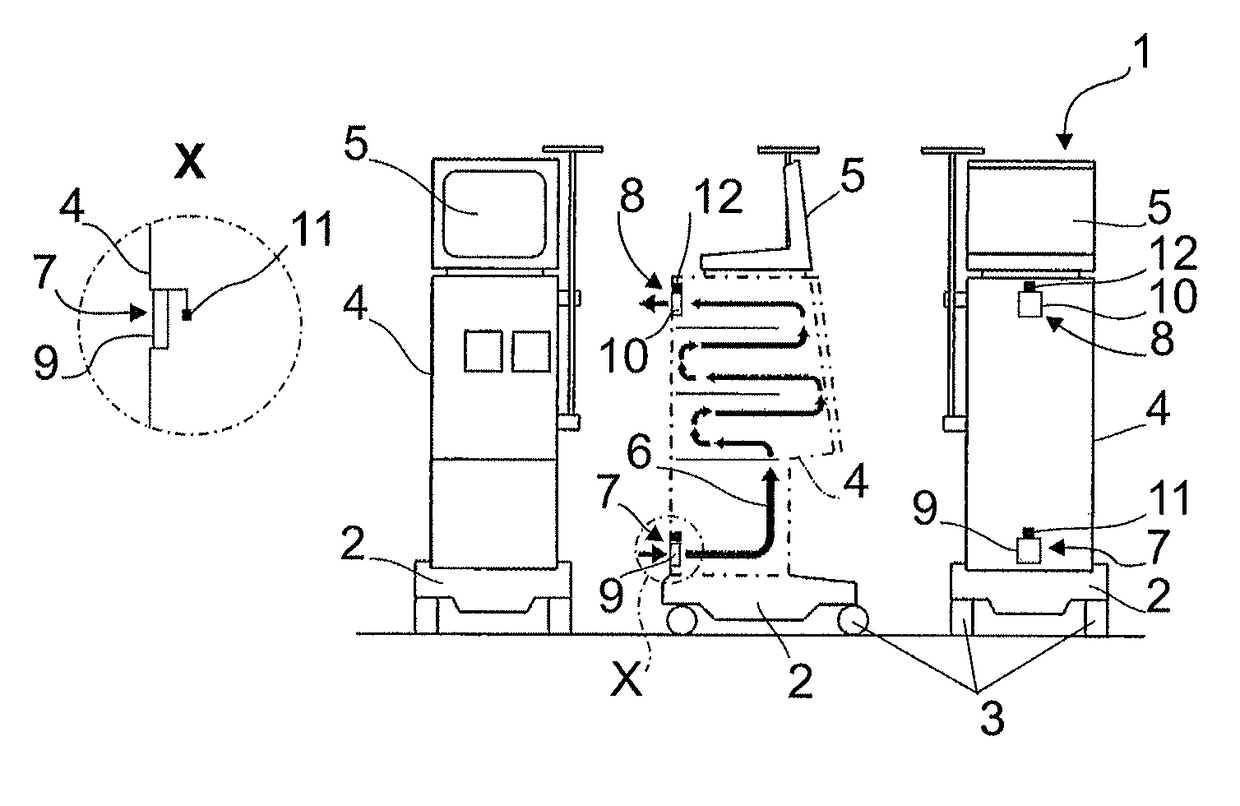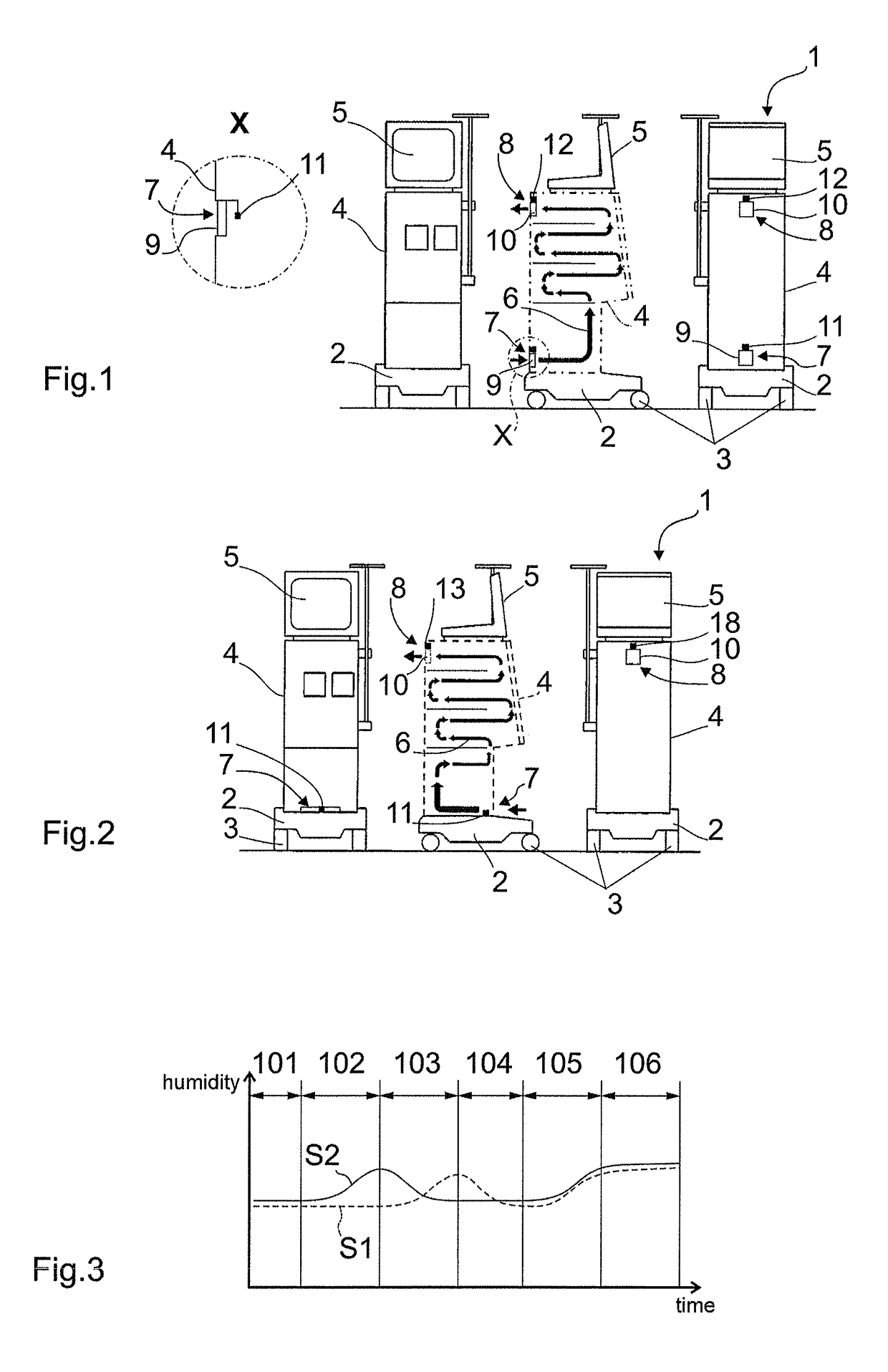[0007]Based on the afore-described state of the art, it is an object underlying the present invention to eliminate the afore-stated drawbacks, especially to provide a possibility of leakage detection in the dialysis fluid system of an extracorporeal blood treatment machine, preferably a dialysis machine, which works comparatively safely, accurately and reliably in the case of small leakage quantities, by which continuous monitoring of the system in terms of leakage is possible, especially also during a current treatment substantially without disturbance thereof, which causes or requires no substantial extension or interruption of the treatment and is comparatively inexpensive.
[0014]In a preferred embodiment of the invention the at least one venting means includes a blower or is formed by the same. Such blower can be provided anyway under certain circumstances in the dialysis machine and preferably can serve for a parallel or simultaneous cooling of the machine. Especially advantageously, the housing can be vented by the venting means, i.e. air can be conveyed out of the housing by the venting means, preferably into the environment. In the housing a vacuum is formed vis-à-vis the environment so that the probability of inadvertent air leak except via the ventilation means or the outlet air aperture can be reduced by which air leak detection of humidity introduced into the air inside the housing due to leakage could be falsified or prevented.
[0018]In order to be able to safely detect even small leakages that cannot be detected in the case of a volume or mass flow ensuring sufficient cooling of the machine (i.e. a volume / mass flow which is relatively high), as the increase in humidity of the air quantity flowing through the housing would be too small for being detected, a measuring cycle can be interspersed in which the airflow guided through the housing can be set to be very small (smaller than the value set as a standard) or as small as possible. During such measuring cycle sufficient cooling of the machine might no longer be completely provided, however in this way also small leakages can be safely detected, as due to the small volume / mass flow and the low flow rate, respectively, they cause an increase in humidity of the airflow guided through the housing in the case of leakage which is sufficient or distinct for being detected.
[0019]In order to be able to detect minimal leakages in an embodiment of the invention the airflow through the housing is stopped for a particular period of time, especially prior to a measuring cycle, e.g. by completely down-regulating the venting means. During this period of time in which no air is flowing through the housing, even in the case of minimal leakages an increase (enrichment) in humidity of the air quantity present in the housing occurs, which can be easily and safely determined during subsequent measurement. In total, the invention advantageously allows detecting leakages almost independently of the quantity and / or the mass or volume flow of the escaping dialysis fluid over a wide range of mass and volume flows. It is possible to reliably and quickly detect leakages of different magnitude, even small and minimal leakages. Cooling of the machine can be operated without any substantial impairment.
[0022]In an advantageous embodiment of the method of the invention the system can be calibrated, especially before the start of treatment. It can be checked whether fluid is provided inside the housing of the dialysis machine. In this case after a first ventilation cycle of the housing the direction of the flow through the housing is reversed. In the event that inside the housing no fluid is provided, an offset of the sensor used for detecting parameters of the inflowing or outflowing air quantity is equal in the normal direction of flow and in the reversed direction of flow through the housing. If fluid, especially dialysis fluid, has escaped from the dialysate system due to a leak and is present in the interior of the housing, the two offset values measured during calibration are different. The sensor at the respective outlet air aperture indicates the higher value. When the offset remains constant in both directions of flow through the housing, it can be compensated by calibrating the sensor. Of particular advantage, such checking or calibration by reversing the direction of flow of the air through the housing can also be carried out during a treatment without impairing the latter.
[0023]According to an embodiment of the invention, the direction of flow through the housing is repeatedly alternated, especially regularly alternated. This can be done in parallel to the usual treatment operation. In this way, a drift of the sensor / sensors can be detected more or less promptly and can be corrected, if desired. Moreover, pollution of the inlet and / or outlet air aperture can be reduced by repeated reversal of the direction of flow through the housing. Finally a plausibility check can be performed by reversing the direction of flow through the housing 4 after additional humidity has been determined in the housing. In this way it can be determined whether an increase in the measuring value was in fact caused by dialysis fluid entered from the dialysis fluid system into the housing or else is based only on a measuring error or on increasing air humidity of the ambient air. Thus the number of false alarms can advantageously be reduced and the reliability of the system and the method, respectively, can be improved.
 Login to View More
Login to View More  Login to View More
Login to View More 

